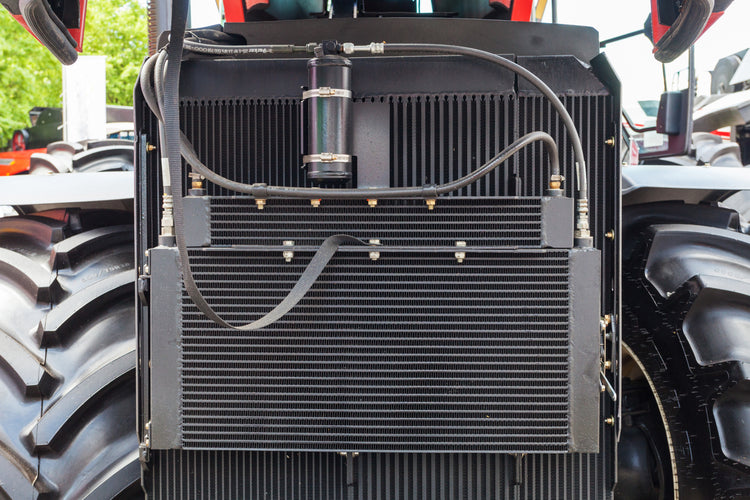Radiators play an important role in keeping the engines of tractors and lawn mowers cool. Tractors are designed to handle heavy workloads, and lawn mowers are required to work for extended periods, making it essential to have a cooling system that works efficiently. This article provides a detailed overview for OEM and aftermarket radiators for tractors and lawn mowers, their functions, and how to fix overheating issues.
Function of Radiator in a Tractor
The primary function of the radiator in a tractor is to maintain the optimal operating temperature of the engine. The engine generates a considerable amount of heat during operation, and if left uncontrolled, the engine may suffer severe damage. The radiator ensures that the engine runs within the correct temperature range by dissipating the excess heat produced by the engine.
Do Tractors Have Radiators?
Yes, most tractors come equipped with a radiator that is responsible for cooling the engine. The size and design of the radiator may vary depending on the make and model of the tractor. In some cases, tractors may have multiple radiators to ensure efficient cooling of the engine.
Lawn Mower Radiator
While most lawn mowers do not have a radiator, some high-end models may come equipped with one. These lawn mowers typically have a liquid-cooled engine, which requires a radiator to dissipate the heat generated during operation. Lawn mowers with air-cooled engines do not require a radiator as they use air to dissipate the heat generated during operation.
Radiator in Tractor
The radiator in a tractor is an essential component of the cooling system. It is typically mounted at the front of the engine and is connected to the engine through hoses. The radiator works by circulating coolant through the engine, which absorbs the excess heat generated during operation. The heated coolant is then passed through the radiator, where it is cooled before being circulated back into the engine.
Tractor Radiator Fan
The radiator fan in a tractor is responsible for drawing air through the radiator to aid in the cooling process. The fan is typically mounted behind the radiator and is driven by a belt connected to the engine. As the fan rotates, it creates a flow of air that passes through the radiator, aiding in the dissipation of heat.
Tractor Radiators by Size
Tractor radiators are available in a variety of sizes, depending on the make and model of the tractor. The size of the radiator is typically determined by the engine size and the operating conditions of the tractor. Tractors that are used for heavy-duty workloads may require larger radiators to ensure efficient cooling of the engine.
How to Fix an Overheating Lawn Mower?
If your lawn mower is overheating, there are several things you can do to fix the issue. Firstly, ensure that the air filter is clean, as a clogged air filter can cause the engine to overheat. Check the oil level and ensure that it is at the correct level, as low oil levels can also cause overheating. If the issue persists, check the cooling system for leaks or blockages. In some cases, the problem may be due to a faulty thermostat or water pump, which may need to be replaced.
How Do Lawn Mower Engines Not Overheat?
Lawn mower engines typically use air-cooling or liquid-cooling systems to prevent overheating. Air-cooled engines use a fan and fins to dissipate heat, while liquid-cooled engines use a radiator to dissipate heat. Proper maintenance of the engine, such as regular oil changes and air filter replacement, can also help prevent overheating.
How Do I Know If My Lawn Mower Is Overheating?
The most common signs of an overheating lawn mower include a hot or burning smell coming from the engine, the engine running sluggishly or losing power, or the engine shutting off unexpectedly. The engine may also emit white smoke, indicating a coolant leak or a damaged head gasket. If you notice any of these symptoms, it is essential to stop the engine immediately and allow it to cool down before investigating further.
How Do Lawn Mower Engines Stay Cool?
Lawn mower engines stay cool through a combination of air and liquid-cooling systems. Air-cooled engines use fins and a fan to dissipate heat, while liquid-cooled engines use a coolant that circulates through the engine and a radiator to dissipate heat. Proper maintenance of the engine, such as cleaning the fins, replacing the air filter, and checking the oil level regularly, can help ensure efficient cooling of the engine.
Conclusion
Radiators play a critical role in maintaining the optimal operating temperature of tractors and lawn mower engines. Proper maintenance of the cooling system, such as checking for leaks or blockages, replacing faulty components, and ensuring proper airflow, can help prevent overheating and ensure the long-term health of the engine. If you experience any issues with overheating, it is important to investigate the problem immediately to prevent further damage to the engine.
At My Parts Store, we pride ourselves on carrying a wide selection of top-quality aftermarket brands that fit a variety of popular brands, including Massey Ferguson, Kubota, Ford New Holland, Case International Harvester, Polaris, and John Deere. Our selection of replacement parts and accessories includes everything from radiators and radiator caps to belts, filters, and more. Whether you're a farmer, landscaper, or home gardener, our knowledgeable team is here to help you find the right parts and accessories for your specific needs. Shop with confidence knowing that our products are backed by our commitment to quality, affordability, and customer satisfaction.



